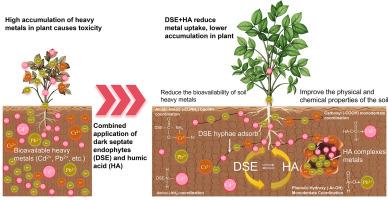暗隔内生菌与腐植酸在重金属污染土壤修复中的应用前景
Q1 Environmental Science
引用次数: 0
摘要
土壤重金属污染对全球农业和生态环境构成严重威胁,并通过食物链危害人类健康。目前,绿色可持续的生物修复技术在土壤重金属污染的治理中得到了广泛的关注,包括植物修复、微生物修复和有机改质修复。其中,暗隔内生真菌(DSE)和腐植酸(HA)表现出显著的效果。本研究从Web of Science和PubMed等数据库中检索相关文献。重点研究了DSE和HA在农业和矿业影响地区重金属污染修复中的作用机制和应用。系统地综述了它们各自作用的原理、技术限制和联合应用的潜在协同策略。但其综合应用在重金属污染土壤修复中的协同机制有待进一步深入研究。本研究在土壤修复领域提出了新的见解和方法,从而为应对全球重金属污染挑战提供了更有力的支持。本文章由计算机程序翻译,如有差异,请以英文原文为准。

Application prospects of dark septate endophytes and humic acid in the remediation of heavy metal contaminated soil
Soil heavy metal contamination has posed a severe threat to the agriculture and ecological environments globally, and jeopardized human health through the food chain. Currently, green and sustainable bioremediation technologies have received extensive attention in the treatment of soil heavy metal pollution, including phytoremediation, microbial remediation, and organic amendment remediation. Among them, dark septate endophytic fungi (DSE) and humic acid (HA) have demonstrated notable efficacy. In this study, relevant literature was retrieved from databases, including Web of Science and PubMed. The research focuses on the mechanisms and applications of DSE and HA in the remediation of heavy metal pollution within agricultural and mining-affected regions. The principles of their individual actions, technical limitations, and potential synergistic strategies for combined application were systematically reviewed. However, the synergistic mechanism of their integrated application in the remediation of heavy metal-contaminated soils requires further in-depth investigation. This study presents novel insights and methods in the field of soil remediation, thereby providing more robust support for addressing global heavy metal contamination challenges.
求助全文
通过发布文献求助,成功后即可免费获取论文全文。
去求助
来源期刊

Bioresource Technology Reports
Environmental Science-Environmental Engineering
CiteScore
7.20
自引率
0.00%
发文量
390
审稿时长
28 days
 求助内容:
求助内容: 应助结果提醒方式:
应助结果提醒方式:


